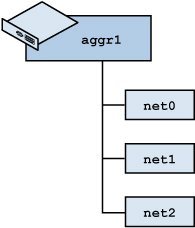Overview of Link Aggregations
Link aggregation is a method to combine several physical datalinks on a system to improve the bandwidth for applications. These physical datalinks are configured together as a single logical unit to increase the throughput of network traffic and to achieve high availability at the datalink layer.
Deploying Link Aggregation Configurations
In Oracle VM server for SPARC, you can configure a virtual switch to use a link aggregation. You can use a link aggregation as a network device of the virtual switch to connect to the physical network. This configuration enables the virtual switch to leverage the features such as increased bandwidth, load balancing, and failover that are provided by the IEEE 802.3ad Link Aggregation standard. For more information, see Using Link Aggregation With a Virtual Switch in Oracle VM Server for SPARC 3.3 Administration Guide.
You can include any link aggregation that is listed in the available NICs as an individual interface by using Oracle Enterprise Manager Ops Center. You can also display the details of both trunk and DLMP aggregation by using Oracle Enterprise Manager Ops Center. For more information about the Oracle Enterprise Manager Ops Center, see http://www.oracle.com/pls/topic/lookup?ctx=oc122&id=OPCCM.
The following figure shows an example of a simple link aggregation configured on a system.
Figure 1 Link Aggregation Configuration

The illustration shows an aggregation aggr1 that consists of three underlying datalinks, net0, net1, and net2. These datalinks are dedicated to serve the traffic that traverses the system through the aggregation. The underlying links are hidden from external applications. Instead, the logical datalink aggr1 is accessible.
Benefits of Link Aggregation
-
Increased bandwidth – The capacity of multiple links is combined into one logical link.
-
Automatic failover and failback – The traffic from a failed link is automatically switched over to other working links in the aggregation, thereby achieving high availability.
-
Improved administration – All underlying links are administered as a single unit.
-
Less drain on the network address pool – The entire aggregation can be assigned one IP address.
Link aggregation has the following benefits:
Because link aggregation groups multiple links into a single logical datalink, features of datalinks such as link protection and resource management work well with link aggregations. For information about link protection, see Chapter 1, Using Link Protection in Virtualized Environments in Securing the Network in Oracle Solaris 11.3. For information about resource management, see Chapter 7, Managing Network Resources in Managing Network Virtualization and Network Resources in Oracle Solaris 11.3.
Link aggregation overcomes some of the problems that are encountered when using high availability features with network virtualization, for example IPMP. With link aggregation, you create the aggregation in a global zone first, then specify it as the underlying link when you configure the non-global zone. When the zone boots, it is assigned a virtual network interface card (VNIC) on the link aggregation. Unlike IPMP, which needs to be configured in every non-global zone, link aggregations are configured in global zones only and provide highly available VNICs to non-global zones. The global zone can also configure properties such as bandwidth on the VNICs assigned to the zone.
Note - Link aggregations perform similar functions to IP multipathing (IPMP) to improve network performance and availability at the datalink layer. For a comparison of these two technologies, see Link Aggregations and IPMP: Feature Comparison.
-
Trunk aggregations
-
Datalink multipathing (DLMP) aggregations
The following types of link aggregations are supported:
For the differences between these two types of link aggregations, see Comparing Trunk and DLMP Aggregation.